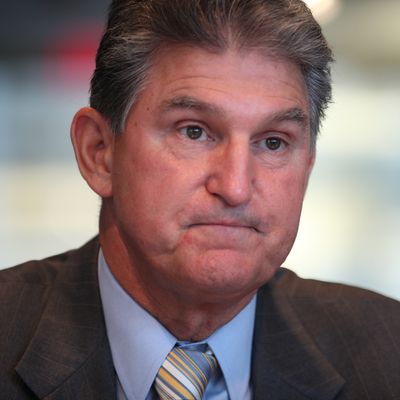
Last Friday Joe Manchin, the Democratic senator from West Virginia, separated himself not just from his party’s liberal flank, but from other conservative Democrats when he voted to confirm Brett Kavanaugh to the Supreme Court. Kavanaugh didn’t really need any Democratic support — with Susan Collins’s vote, he’d already secured confirmation — but this makes Manchin’s position all the more notable. Maybe the senator cast his vote strategically; he’s up for reelection in November. But he’s led his Republican challenger, Patrick Morrissey, consistently in polls, and his position is certainly more secure than that of fellow Democratic moderate Heidi Heitkamp, who voted against Kavanaugh even though she appears to be losing her race for reelection. The simplest explanation is that Manchin, like Collins, disbelieves the sexual assault allegations against Kavanaugh, and is convinced the judge is fit to serve.
Manchin’s support for Kavanaugh didn’t surprise anyone familiar with the senator’s conservative record. The senator votes along with Donald Trump’s agenda over 61 percent of the time, according to data from FiveThirtyEight, and Democrats have long tolerated that rightward tilt in the name of political pragmatism. Democrats like Joe Manchin are the only Democrats that can win states like West Virginia — or at least that’s what party wisdom dictates. “If you want to have a Democratic Party in places like West Virginia, you have to be happy about somebody like Joe Manchin, right?” Connecticut senator Chris Murphy told Politico last April.
But Manchin’s vote should call old party strategies into question. If the Democratic Party can’t count on its own senators for votes as morally pivotal as the Kavanaugh confirmation, its big tent might just be too big. Its tolerance for conservative members might not be as pragmatic as it appears, either. Since Trump took office in 2016, a number of Democrats to Manchin’s left have performed surprisingly well in so-called red states, winning some unexpected primary elections and polling well against Republican candidates. The Democratic candidate for Florida governor, Andrew Gillum, has been campaigning on Medicare for All and still leads Republican Ron DeSantis by four points in a recent Florida Southern College poll. In Georgia’s gubernatorial race, progressive Stacey Abrams has locked Republican Brian Kemp in a dead heat. In other races, recent polling suggested that progressive congressional candidates Jess King and Randy Bryce, running in Pennsylvania’s 11th Congressional District and Wisconsin’s First Congressional District respectively, have closed gaps with their Republican opponents to single digits. And in one of the year’s most surprising contests, Democrat Beto O’Rourke has trapped Ted Cruz in a race for his political life.
Even in West Virginia, support for Trump doesn’t necessarily guarantee support for down-ballot Republican candidates, or for conservative politics as a category. Trump won 68 percent of the vote in 2016. But less than half of the state’s registered voters actually voted for Trump. The president won 489,671 of the state’s registered voters, out of a 2016 total of 1,274,887. In the state’s conservative Third Congressional District, Democrat Richard Ojeda has managed to turn his race against Republican Carol Miller into a true toss-up. That’s partly due to Ojeda’s particular idiosyncrasies: Like many of his would-be constituents, he voted for Trump, though it’s a decision he says he now regrets. As a state legislator, his unyielding support for the teachers’ strike that gripped the state in February and March earned him an energized following that very well could put him in office. Politically, Ojeda now has more in common with Bernie Sanders than he does with Joe Manchin — and that tilt to the left has hardly harmed his prospects.
Manchin himself faced a primary challenge from the left. He won, decisively, but Paula Jean Swearengin’s final showing against the senator bears re-examination. For Swearengin, an environmental activist with no name recognition and no campaign budget to speak of, to earn 30 percent of the vote against Manchin, who has served as senator since 2010 and was governor before that, indicates that progressive opposition to the senator is hardly nonexistent. After all, this is the same state where Bernie Sanders handily trounced the more centrist Hillary Clinton in 2016’s Democratic primary.
These facts don’t entirely rebut the notion that as a Democratic senator from West Virginia, Manchin has shouldered a difficult task. The state’s Democratic Party is in disarray: Jim Justice, the current governor, ran as a Democrat only to switch parties after taking office, and Republicans dominate the state legislature. Most West Virginians may not have voted for Trump, but that doesn’t mean the president lacks a strong base in the state. While Manchin’s reelection bid doesn’t appear to be in major trouble, his support for Kavanaugh may well help shore it up. The Washington Post’s Greg Sargent reported on Monday that according to at least one Democratic strategist, internal polling suggests that the Kavanaugh fight may boost Republican Senate candidates. It’s certainly not in the party’s interests for the senator to formally switch parties. Manchin still keeps a coveted Senate seat in Democratic hands, and there’s a chance, albeit a small one, that he could help give the party control of the chamber in November.
Democrats are clearly stuck with Manchin for now. The senator’s reelection seems like a sure bet, and the same can’t be said for every progressive candidate running in 2018. The real question, though, isn’t whether the party should shun him today, but whether it should continue to settle for conservatives with uncertain loyalties — and the party arguably can’t answer that until it figures out what it wants to be. All its efforts to brand itself a party of the people, from the Better Deal platform to its emerging tolerance for left-wing policies like Medicare for All, look like pandering as long as it allows conservatives like Manchin into the fold.
“The Democrats have got their clocks cleaned the last three or four election cycles and, frankly, no one seems to know what we even stand for anymore,” Jeffrey Kessler, a former Democratic state senator who lost to Justice in the gubernatorial primary, told West Virginia Metro News last August. “It’s just we’re going to be this ‘West Virginia Democrat’ which, at the end of the day, is nothing more than Republican-lite.”
The necessity of right-leaning, red-state Democrats might not be good strategy, but rather a self-fulfilling prophecy.
This post has been updated to clarify Trump’s performance in West Virginia in 2016.






























